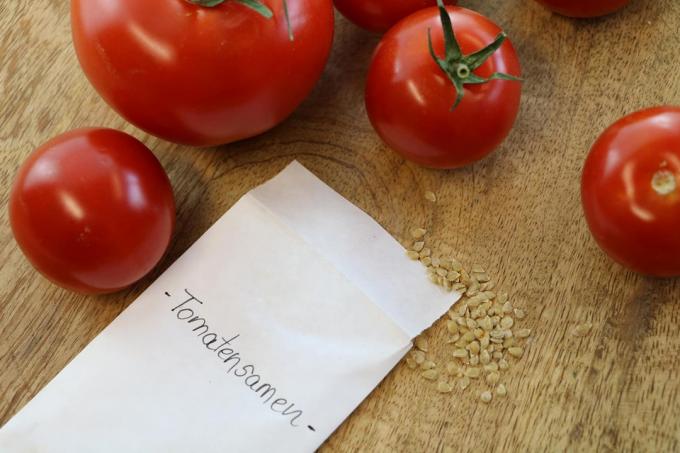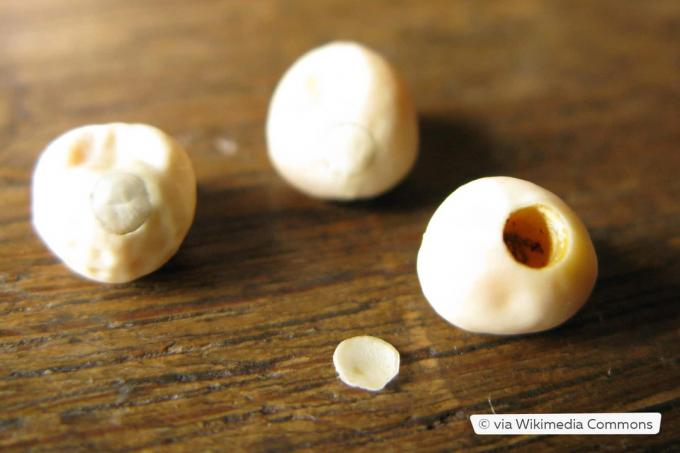
Self-collected or purchased seeds are the basis for the gardener for the next gardening season, if they are stored correctly. In this way, the germination capacity of some species is retained for decades.
In a nutshell
- The germination capacity of the seeds remains limited even if they are stored well
- Always label containers with the type and year of collection
- store dry and cool
- choose tight containers to prevent pests and moisture
- freezing is possible, but involves a great deal of effort
Table of contents
- Consider germination
- Label seeds
- temperature
- climate
- container
- Freeze seeds
- frequently asked Questions
Consider germination
No seed can be kept indefinitely under normal storage conditions. Umbelliferous plants in particular, which include, for example, carrots, parsley or parsnips, have a short germination capacity. On average, the germination rate of the seeds drops to 50% in just one to two years. Bulbous plants such as leeks or spring onions also have a short germination rate and you should always use up the seeds quickly.

The following seeds, on the other hand, last a long time:
- cucurbits
- tomatoes
- Aubergines (some varieties have a shelf life of more than 20 years)
- chard
- Beetroot
- Mustard (shelf life over 40 years)
Label seeds
Before you start with optimal storage, you should always label the seed. Here the year in which it was collected is particularly important. Seeds are often collected and, without labeling, it is often not even possible to identify the species from the seeds alone.

Always put a roll of painter's tape with the containers or bags in which you collect or store the seeds. The tape is easy to write on and sticks well to different surfaces.

When collecting, always make sure to remove the first ripe seeds from fruit that is in perfect condition. These seeds are already genetically programmed to ripen a little earlier. With tomatoes, for example, if you consistently harvest the first fruit for seed propagation, you can prematurely ripen them by a few weeks in the next few years.
temperature
The optimal storage temperature for seeds is 10 °C. The temperature can be slightly lower but not higher as the heat can damage the seedling if it is not given a chance to germinate.
Cool anterooms or a dry basement, for example, are ideal. An attic is unsuitable due to the high temperature fluctuations.
climate
Always store seeds dry. This can sometimes lead to problems at the required cool temperatures. However, humid air can cause light germinators to start growing. In addition, a damp environment favors the formation of mold and bacteria on the seeds, which can later damage the seedling or the plant. A maximum humidity of 60% is ideal.
The seed should always be completely dry before storage. A temperature of around 20 °C is ideal for drying the seeds.
Gather the small packets of silica gel that are often included in the box with clothing, shoes or electronic devices and place them in the seed containers. The gel absorbs the moisture and keeps it away from the seeds.
container
Store the seeds in containers that are as airtight as possible. While they don't necessarily have to be dark for seeds to be protected from light, airtight storage containers can help prevent pests or moisture.
Pests in particular can be a big problem because they can destroy most of the seed. Try to store the seeds separately, for example according to plant families, to prevent them from spreading to other seeds.
The following pests are problematic during storage:
- bean beetle
- pea beetle
- moths
- grain weevil

Watch out for pests before storing the seeds properly. In the case of beans and peas in particular, the harmful insects are already in the seeds. Before you put the seeds in the container provided, leave the seeds a little warmer while they dry. As a result, the beetles hatch and you can immediately dispose of contaminated seeds together with the pest.
At beans and Peas it has proven useful if you vacuum-pack the seeds in small portions in suitable bags. This means that contamination is limited to the respective bag.
Freeze seeds
Many hobby gardeners know the Svalbard Global Seed Vault. This is about a huge seed bank in Norway, where at -18 °C all sorts of seeds from all over the world are stored for emergencies. The germinability of seeds can be preserved for decades and it is theoretically possible to recreate this yourself with a freezer. For some species, such as umbelliferae, this can make sense, but this method is associated with a lot of effort and problems for private users.
Possible problems:
- Frost damage caused by seed that has not dried completely
- Formation of condensation when opening the container
- Delayed germination due to a longer adaptation process to the ambient temperature
If you are going to freeze seeds, it is important that you remove moisture from the seeds during drying. This does not work when drying in a dry room climate, since the air still contains too much moisture. Place the seeds in a tight container with silica gel, which you can purchase in bulk in stores.
frequently asked Questions
With older seeds, it makes sense to do a germination test before sowing. To do this, put about 10 to 20 seeds on a piece of damp kitchen paper and place it in a sealed freezer bag. For a seed to be considered germinable, at least 60% of the seeds must germinate.
As a rule, you should find an imprint on every seed package stating when the seed was bottled or when it was filled. how long it lasts. At least one of these pieces of information is given. There is also information on germination, because this is not always 100%, even with purchased species.
There are different methods to germinate even older seeds. One method is stratification. Cold germs are specifically exposed to an optimal temperature so that the germ stimulus is stimulated. There is also fermentation, in which, as with the tomato, the seed is placed in water for a few days when it is collected, so that the protective layer around the seed, which inhibits germination, dissolves. Pre-soaking in lukewarm water or roughening the seed coat with sandpaper for larger seeds is also helpful for the start.



